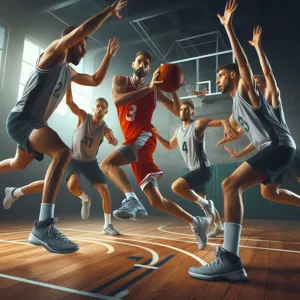In the fast-paced world of basketball, where split-second decisions can make the difference between victory and defeat, mastering footwork is an essential skill that all players must prioritize.
whether you’re a seasoned athlete or just starting your journey on the court, honing your footwork can significantly enhance your agility, balance, and overall performance. From swift pivots to explosive first steps, the right footwork drills can transform your game and give you the competitive edge you need. In this blog post, we’ll explore the top five footwork drills every basketball player should master. These drills are designed to build muscle memory, improve coordination, and ensure you’re always one step ahead of your opponents. Get ready to elevate your game and take your skills to new heights!
1. Introduction to the Importance of Footwork in Basketball

Footwork is the foundation upon which the game of basketball is built. Every dribble, pass, and shot hinges on how well a player can position their feet for balance, speed, and agility. Whether you’re a seasoned player or just starting, mastering footwork can elevate your performance on the court and set you apart from your competition.
In basketball, footwork plays a crucial role in both offensive and defensive strategies. On offense, effective footwork allows players to create space, make quick cuts, and execute shooting techniques with precision. A well-timed jab step or a pivot can leave defenders off-balance and open up scoring opportunities. Conversely, on defense, solid footwork is vital for staying in front of your opponent, maintaining good positioning, and contesting shots without committing fouls.
Moreover, footwork is not just about speed; it also encompasses balance and body control. A player with excellent footwork can navigate through tight spaces, absorb contact, and maintain their composure even in the heat of the game. Practicing footwork drills not only strengthens these skills but also builds muscle memory, ensuring that your feet instinctively know what to do when the pressure is on.
In this post, we’ll delve into five essential footwork drills that every basketball player should master. These drills are designed to enhance your agility, improve your shooting stance, and refine your defensive techniques, ultimately transforming your game. Let’s lace up our sneakers and get ready to elevate our footwork to the next level!
2. Drill 1: The Defensive Slide Drill
The Defensive Slide Drill is a fundamental exercise that every aspiring basketball player should master to enhance their lateral movement and defensive agility. This drill focuses on improving footwork, balance, and the ability to stay low and engaged while guarding an opponent.
To set up, find a clear area on the court and imagine a straight line between two cones or markers about 10 to 15 feet apart. Start at one cone, assuming a low defensive stance with your knees bent, back straight, and feet shoulder-width apart. The key to success in this drill is maintaining a low center of gravity, which allows for quicker reactions and better balance.
From the starting point, push off with your outside foot and slide laterally towards the opposite cone, ensuring that your feet don’t cross over. Keep your head up to maintain awareness of your surroundings, as if you were tracking an opponent on the court. As you slide, your hands should be active, ready to contest a shot or intercept a pass.
Once you reach the second cone, push off again, returning to the starting position. To maximize the effectiveness of this drill, aim for speed without sacrificing form. Practicing this drill regularly will help develop muscle memory, allowing you to react instinctively during games.
As you become more comfortable with the basic slide, you can add variations such as changing directions, incorporating quick pivots, or adding a basketball for ball-handling practice. The Defensive Slide Drill not only enhances your footwork but also builds endurance and strengthens the muscles used for effective lateral movement, making it an essential component of any player’s training regimen. By mastering this drill, you’ll be better equipped to lock down your opponents and contribute to your team’s defensive strategy.
3. Drill 2: The Jab Step and V-Cut Drill

The Jab Step and V-Cut Drill is a fundamental exercise that not only enhances a player’s footwork but also sharpens their ability to create space and read defensive movements. This drill is crucial for players looking to improve their offensive game and develop effective scoring options.
To begin, position yourself at the three-point line, facing the basket. Start with your feet shoulder-width apart, knees slightly bent, and a basketball in your hands. The first part of the drill focuses on the jab step. Take a quick, explosive step forward with one foot, while simultaneously planting the opposite foot. This jab should be sharp and decisive, simulating a drive toward the basket. The goal here is to sell the move to your imaginary defender, forcing them to react and potentially opening up space for further movement.
Once you’ve executed the jab step, seamlessly transition into the V-cut. This involves pushing off the foot opposite your jab, taking a hard step back to create separation from the defender, and then cutting sharply at an angle back toward the basket. The key to a successful V-cut is to maintain a low center of gravity and explode out of the cut, making sure to quickly reposition your feet for a potential shot or pass.
As you practice this drill, focus on your foot placement, body control, and the fluidity of your movements. Incorporate variations by changing the speed of your jab steps or the direction of your cuts. This will not only improve your agility but also help you become more unpredictable on the court.
By mastering the Jab Step and V-Cut Drill, players can enhance their ability to create scoring opportunities and keep defenders guessing—an essential skill for any aspiring basketball player. Make this drill a regular part of your training routine, and watch as your footwork and offensive game elevate to new heights.
4. Drill 3: The Cone Shuffle Drill
The Cone Shuffle Drill is an essential exercise for any basketball player looking to enhance their lateral movement and overall agility on the court. This drill focuses on developing quick footwork and improving your ability to respond to opponents’ movements, making it a vital addition to your training regimen.
To set up the Cone Shuffle Drill, start by placing three cones in a straight line, each about three to five feet apart. Stand at the center cone, facing either direction, and get into a low athletic stance with your knees slightly bent, feet shoulder-width apart, and your weight balanced on the balls of your feet.
The objective is simple yet challenging: shuffle laterally from the center cone to the left cone, touching it lightly before shuffling back to the center, and then immediately shuffling to the right cone. Maintain a low center of gravity, keeping your hips low and your feet light as you move side to side. The key is to avoid crossing your feet; instead, push off from your outside foot with every shuffle. This will help you build strength in your legs and improve your stability as you change directions quickly.
To increase the intensity of the drill, you can add variations such as incorporating a dribble while shuffling or increasing your speed with each repetition. Aim for quick, explosive movements—your goal is to be as fast and efficient as possible. Performing this drill for 30 seconds at a time, followed by short breaks, will challenge your endurance while honing your footwork skills.
Incorporating the Cone Shuffle Drill into your regular practice routine can significantly enhance your defensive capabilities and offensive maneuverability. Mastering this drill will not only improve your agility but also give you a competitive edge during games, allowing you to stay one step ahead of your opponents.
5. Drill 4: The Reverse Pivot Drill

The Reverse Pivot Drill is a fundamental exercise that every basketball player should master, regardless of their position on the court. This drill focuses on enhancing footwork, agility, and the ability to make quick decisions while maintaining a strong offensive stance.
To start, find a space where you have enough room to move freely. Position yourself with your back to the basket, imagining the defender is right behind you. Begin the drill by receiving a pass or simulating a catch. As you receive the ball, plant your pivot foot firmly on the ground.
From this position, practice your reverse pivot by turning your body 180 degrees, using your pivot foot to maintain balance and control. As you pivot, keep your other foot light, ready to explode in any direction. This movement not only helps you protect the ball from a defender but also creates space for a jump shot or a drive to the basket.
To add complexity, incorporate a defender into the drill. Have a teammate apply light pressure as you perform the reverse pivot. This added resistance will help simulate game conditions, allowing you to practice your footwork under pressure. Focus on maintaining your balance and keeping your dribble low while assessing your shooting or passing options.
The Reverse Pivot Drill can be repeated multiple times, gradually increasing the speed and intensity. Incorporating this essential drill into your training regimen will enhance your ability to navigate tight defenses, making you a more versatile and unpredictable player on the court. Mastering this technique not only boosts your footwork but also builds your confidence in high-pressure situations, ensuring you’re always ready to make that game-winning play.
6. Drill 5: The Two-Ball Dribbling Footwork Drill
The Two-Ball Dribbling Footwork Drill is an advanced exercise that simultaneously develops your dribbling skills and footwork, making it an essential part of any serious basketball player’s training regimen. This drill not only enhances your ball-handling abilities but also reinforces coordination and agility—key components in navigating the court effectively.
To perform the drill, start by standing with your feet shoulder-width apart, holding a basketball in each hand. Begin dribbling both balls simultaneously, ensuring that your knees are slightly bent and your posture is low. The key here is to maintain control of both basketballs while keeping your head up to improve your court awareness.
As you become more comfortable with the dual dribble, incorporate different movements. Start by moving laterally—side to side—while maintaining your dribble. This helps simulate the quick lateral movements needed to evade defenders. Once you’ve mastered lateral movement, challenge yourself by adding forward and backward dribbling. This variation will enhance your ability to change direction quickly, crucial for breaking past defenders during a game.
To increase the drill’s intensity, incorporate footwork patterns such as crossover steps, jab steps, or even a series of quick pivots. This will not only work on your foot speed but also your ability to make quick decisions on the court. You can also set up cones to weave in and out of, further developing your dribbling control while maneuvering around obstacles.
Aim to perform this drill for several minutes at a time, gradually increasing your speed as you become more proficient. The Two-Ball Dribbling Footwork Drill is not just about repetition; it’s about instilling muscle memory and ensuring that your footwork becomes second nature, allowing you to focus on your overall gameplay when it counts the most. By mastering this drill, you position yourself to outmaneuver opponents and elevate your performance on the court.
7. How to Incorporate Footwork Drills into Your Practice Routine

Incorporating footwork drills into your practice routine is essential for developing a solid foundation in basketball. Mastering your footwork can elevate your game, allowing you to move with agility, maintain balance, and react swiftly to opponents. Here’s how to seamlessly integrate these vital drills into your training sessions.
**Start with a Warm-Up:** Before diving into footwork drills, ensure you warm up properly to avoid injury. Engaging in dynamic stretches and light jogging will prepare your muscles for the explosive movements that lie ahead.
**Set Specific Goals:** Identify what aspects of your footwork you want to improve. Are you looking to enhance your defensive slides, increase your agility for quick cuts, or perfect your pivoting technique? Setting clear goals will allow you to focus your practice and track your progress effectively.
**Create a Structured Routine:** Dedicate a portion of your practice time specifically to footwork. This could be a 15- to 20-minute segment where you rotate through various drills. For example, you might start with ladder drills for quickness, followed by cone drills for directional changes, and finish with post moves that emphasize footwork under pressure.
**Use Visualization Techniques:** As you practice your footwork, visualize game scenarios where these movements would be crucial. Whether it’s envisioning a defender closing in or a teammate setting a pick, this mental rehearsal can enhance your on-court performance.
**Incorporate Partner Drills:** Practicing footwork with a partner can simulate real-game situations. Work on defensive slides while one player acts as the ball-handler, forcing you to adjust your footwork based on their movements. This not only improves your footwork but also builds chemistry with teammates.
**Review and Reflect:** After each practice, take a moment to reflect on what you learned. Did certain drills feel more challenging than others? Were there specific movements that felt unnatural? Keeping a journal of your practice sessions can help you identify areas for improvement and adjust your routine accordingly.
By diligently incorporating these footwork drills into your practice routine, you’ll cultivate a more versatile and effective playing style. Remember, footwork is the backbone of successful basketball play; the more time you invest in honing it, the sharper your skills will become on the court.
8. Common Mistakes to Avoid During Footwork Drills
When it comes to honing your footwork in basketball, mastering the fundamentals is crucial, but avoiding common pitfalls can be just as important. Many players unknowingly fall into habits that hinder their development, so let’s explore some of the frequent mistakes to steer clear of during footwork drills.
**1. Neglecting proper Stance**
A solid foundation begins with your stance. Many players overlook the significance of keeping their feet shoulder-width apart and their knees slightly bent. This posture not only provides balance but also prepares you for quick movements. Avoid the temptation to stand flat-footed or too rigid, as it can limit your agility and responsiveness on the court.
**2. Overlooking Coordination with Upper Body Movement**
Footwork isn’t just about your feet; your upper body plays a vital role too. A common mistake is failing to synchronize your foot movements with your hands and shoulders. Whether you’re pivoting, cutting, or setting up for a shot, ensure that your upper body is engaged and aligned with your lower body. This coordination will enhance your overall effectiveness and fluidity in movement.
**3. Rushing Through Drills**
In the pursuit of speed, many players rush through footwork drills, sacrificing technique for quickness. Remember, precision trumps speed. Focus on executing each movement correctly before increasing your pace. By taking the time to master the intricacies of footwork, you’ll develop muscle memory that will serve you well during game situations.
**4. Forgetting About Conditioning**
Footwork drills can be physically demanding, and it’s easy to neglect conditioning while focusing solely on technique. However, fatigue can lead to sloppy movements and poor decision-making. Incorporate conditioning elements into your footwork drills—think sprinting between cones or adding lateral movements—to build endurance and maintain sharpness even in the late stages of a game.
**5. Ignoring Feedback**
Finally, one of the biggest mistakes players make is ignoring feedback from coaches or peers. Constructive criticism is essential for growth. Record your drills or practice in front of a mirror to observe your form and identify areas for improvement. Welcome input from experienced players, as their insights can provide valuable perspectives on your technique.
By avoiding these common mistakes, you can ensure that your footwork drills are not only effective but also a stepping stone to becoming a more skilled and agile basketball player. Remember, consistency and mindfulness in practice will lead to significant improvements on the court.
9. Tips for Improving Agility and Speed
Agility and speed are crucial components of effective footwork in basketball. They can mean the difference between a successful drive to the hoop and being easily defended, or between getting open for a shot and being shut down by an opponent. Here are some tips to help you enhance your agility and speed on the court:
1. **Incorporate Ladder Drills**: Agility ladders are fantastic tools for improving foot speed and coordination. Practice various patterns—like the one-foot in, one-foot out, lateral shuffles, and the Ickey shuffle—to develop quicker, more precise foot movements. The more you challenge your footwork, the more naturally it will translate to your gameplay.
2. **Plyometric Exercises**: Engaging in plyometric workouts, such as box jumps, lateral hops, or jump squats, can significantly increase your explosiveness on the court. These drills condition your muscles to react quickly, helping you accelerate faster and change directions with ease.
3. **Strength Training**: Building strength in your legs isn’t just about bulk; it’s about functional strength that translates to on-court performance. Focus on exercises like squats, lunges, and calf raises. Not only will these improve your overall power, but they will also enhance your stability, allowing for quicker pivots and better balance.
4. **Interval Sprints**: Incorporate sprinting drills that simulate game conditions. Short bursts of speed, followed by brief periods of rest or lower-intensity movement, will improve your cardiovascular fitness and teach your body to recover quickly. This is crucial for maintaining high levels of performance throughout the game.
5. **Dynamic Stretching**: Before every practice or game, ensure you warm up with dynamic stretching. Movements like high knees, butt kicks, and leg swings not only prepare your muscles for action but also improve your range of motion and responsiveness. This can lead to quicker reactions and a lower risk of injury.
By integrating these strategies into your training regimen, you’ll see noticeable improvements in your agility and speed, translating to better performance on the basketball court. Remember, consistency is key—dedicate time each week to focus on these areas, and soon you’ll find yourself outmaneuvering opponents with ease.
10. The Role of Footwork in Game Situations
Footwork is often the unsung hero of basketball, yet it plays a pivotal role in determining a player’s effectiveness on the court. Whether you’re executing a smooth crossover, finding space for a jump shot, or maintaining defensive pressure, the agility and precision of your footwork can make all the difference in high-pressure game situations.
In a fast-paced environment where split-second decisions can lead to victory or defeat, mastering footwork allows players to react quickly and efficiently. For instance, when driving to the basket, a player needs to utilize a quick jab step to create separation from their defender. This small but impactful movement can open up lanes for an easy layup or a kick-out pass to an open teammate.
Defensively, proper footwork can prevent players from getting beat off the dribble. By adopting a low stance and using quick lateral movements, defenders can stay in front of their opponents, making it difficult for them to penetrate the lane. Additionally, footwork is crucial during closeouts; a well-timed approach can alter a shooter’s rhythm and potentially lead to a missed shot.
Moreover, footwork is not limited to offensive and defensive plays. In transition, a player’s ability to pivot and reposition can dictate the pace of the game. Whether it’s sprinting back on defense or quickly shifting gears to launch a fast break, effective footwork enhances overall team dynamics and fluidity.
Ultimately, understanding the role of footwork in game situations is essential for any aspiring basketball player. By incorporating footwork drills into your training regimen and honing your skills, you’ll not only elevate your individual performance but also contribute to your team’s success on the court. Remember, in basketball, being light on your feet can lead to heavy rewards.
11. Tracking Progress: Measuring Improvement in Footwork
Tracking progress is essential for any basketball player dedicated to mastering footwork. Improvement in this fundamental skill doesn’t happen overnight; it requires commitment, practice, and a keen eye for detail. One of the best ways to measure your advancement is by establishing clear benchmarks and regularly assessing your performance against them.
Start by recording your footwork drills—be it agility ladders, cone drills, or defensive slides. Use a stopwatch to time how quickly you can complete each drill, and aim to reduce those times with each session. Documenting your times not only provides a tangible measure of improvement but also motivates you to beat your previous records. Additionally, try filming yourself during drills. Watching the footage can reveal subtleties in your technique that you might not notice in real-time. Look for areas where you can enhance your speed, balance, and precision.
Another effective method is to set specific goals for each practice. For instance, if you’re working on pivoting, aim to execute a certain number of successful pivots in various situations during a game simulation. After a set period, review your performance—have you become more agile? Are you able to change directions more quickly without losing balance?
Moreover, consider seeking feedback from coaches or experienced players. They can provide valuable insights on your footwork technique, highlighting strengths and areas for improvement that you may overlook. Keeping a training journal can also help; jot down thoughts on what works, what doesn’t, and what you plan to focus on next.
Ultimately, the key to tracking progress is consistency. By regularly measuring your footwork skills, you’ll not only see tangible improvements but also build confidence in your abilities. Remember, proficiency in footwork is a cornerstone of a successful basketball game, and being aware of your progress will fuel your dedication to becoming the best player you can be.
12. Conclusion: The Path to Becoming a Better Basketball Player
In conclusion, mastering footwork is a critical component in the journey of any basketball player aspiring to elevate their game. The drills outlined in this post are not just exercises; they are foundational skills that empower players to enhance their agility, balance, and overall performance on the court. By consistently practicing these footwork drills, you will develop the quickness needed to navigate through defenders, maintain control during high-pressure situations, and create space for your shots.
As you integrate these drills into your training regimen, remember that improvement takes time and dedication. Embrace the process, and don’t shy away from pushing your limits. Each repetition brings you one step closer to becoming a more versatile and effective player. Moreover, as your footwork improves, so will your confidence, allowing you to perform at your best during games and make those critical plays that can change the outcome.
Ultimately, becoming a better basketball player is a journey of commitment, practice, and perseverance. Stay focused on your goals, keep honing your skills, and watch as your hard work pays off on the court. With determination and the right footwork drills in your arsenal, you are well on your way to not only enhancing your individual performance but also contributing to the success of your team. So lace up your sneakers, hit the gym, and let your footwork be the foundation of your basketball prowess!
13. Additional Resources for Basketball Training
As you embark on your journey to refine your footwork on the basketball court, it’s essential to equip yourself with a variety of resources that can enhance your training experience. Whether you’re a beginner looking to develop foundational skills or an advanced player seeking to perfect your technique, there are numerous valuable materials available to help you reach your goals.
**Online Video Tutorials**: Platforms like YouTube are teeming with instructional videos from seasoned coaches and professional players. Channels dedicated to basketball training often break down complex footwork drills into easy-to-follow segments. Watching these tutorials can provide you with visual cues that are vital for proper execution and can inspire variations on drills you may already know.
**Books and E-books**: There are countless books written by basketball legends and coaches that delve into the nuances of footwork and overall game strategy. Titles that focus specifically on skill development can offer insights into not only the mechanics of footwork but also the mental aspects of the game. E-books make it convenient to access this information on the go, allowing you to read and learn during downtime.
**Mobile Apps**: The digital age has given rise to a variety of apps that cater to basketball training. These apps often include customizable workout plans, video demonstrations, and even community features that allow you to connect with other players. Some apps allow you to track your progress and set specific goals, making it easier to stay motivated and accountable.
**Local Clinics and Camps**: Participating in basketball camps or clinics can provide you with hands-on coaching and feedback from experienced trainers. These events often focus on skill development and can be a great opportunity to practice footwork drills in a competitive environment. Not to mention, they allow you to network with other players and coaches who share your passion for the game.
**Forums and Online Communities**: Engaging with fellow players in online forums or social media groups can be a treasure trove of information. These communities often share tips, drills, and personal experiences that can provide new perspectives on training methods. You can ask questions, seek advice, and even find local workout partners to keep you motivated.
By leveraging these additional resources, you can enrich your basketball training regimen and ensure that your footwork is sharp, agile, and game-ready. Remember, mastering footwork is not just about repetition; it’s about understanding the principles behind it and continuously seeking knowledge that will help you excel on the court.
14. Encouragement for Persistence and Consistency
Basketball is as much a mental game as it is a physical one, and the path to mastering footwork drills is paved with persistence and consistency. Every great player has faced challenges, whether it’s struggling with a specific move or simply feeling overwhelmed by the complexity of the game. It’s essential to remember that improvement doesn’t happen overnight. Just like perfecting a jump shot or nailing a three-pointer, mastering your footwork requires dedication and regular practice.
Encouragement for persistence means embracing the ups and downs of the training process. When you hit a plateau or feel frustrated, remind yourself that every professional player has been in your shoes. The difference lies in their unwavering commitment to showing up day after day, putting in the work, and refining their skills. Set realistic goals for yourself and celebrate small victories along the way, whether that’s executing a drill flawlessly or improving your speed.
Consistency is the backbone of any successful training regimen. Design a training schedule that incorporates footwork drills multiple times a week, ensuring you stick to it even when motivation wanes. Consider tracking your progress in a journal, noting what works and what needs improvement. This not only keeps you accountable but also allows you to reflect on your journey and recognize how far you’ve come.
Remember, in basketball, as in life, the key to success is not just talent but the relentless pursuit of excellence. So lace up your sneakers, hit the court, and commit to those footwork drills. With persistence and consistency, you’ll not only enhance your skills but also build the confidence that comes from knowing you’ve put in the effort to be the best player you can be. Keep pushing yourself, and before long, you’ll see the fruits of your labor manifest in your on-court performance.
In conclusion, mastering footwork is essential for any basketball player looking to elevate their game, and the drills we’ve outlined in this post serve as a solid foundation for developing agility, balance, and quickness on the court. By incorporating these top five footwork drills into your regular practice routine, you’ll not only enhance your individual skills but also improve your overall performance during games. Remember, consistent practice and dedication are key to making these techniques second nature. So lace up your sneakers, hit the court, and watch as your newfound footwork translates into more effective plays and a stronger presence in every game. Happy training!






